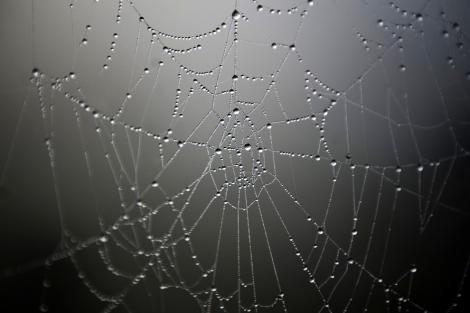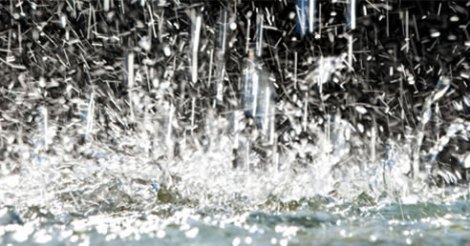
Water beading on a spiderweb. Courtesy Daniel Ochoa de Olza. Our thanks to Associated Press. All rights reserved.
WORLD WATER DAY (March 22) is a powerful reminder of how important water is for life and health of our planet.
Green News Update is providing resources – rather than a polemic – on what you should know and how you can help.
SCROLL DOWN for facts, followed by articles and access to advocacy groups that would appreciate your support.
WATER FACTS
- The water we have on Earth is finite. We are drinking the water that the dinosaurs had available to them.
- 2% of all water on earth is locked in snow and ice; less than 1% is liquid form. (The other 97 % is salt water).
- What does that add up to ? 9.25 million trillion gallons of fresh water on the planet.
- Two thirds of fresh water is frozen — 6.44 million trillion gallons — in icesheets, glaciers, permanent snow cover, and permafrost. ( 2010) Data have probably changed dramatically. The rest is surface and groundwater in liquid form.
- Women in developing countries spend 200 million hours daily seeking and carrying fresh water. They walk an average of 3.7 miles to get fresh water.
- One of 8 people lacks access to clean water. By 2025, 1.8 billion people will live in regions of severe water scarcity
- 46% of people on Earth do not have water piped into their homes. Up to 10% of water traveling through pipes, especially in the US West, may be lost to leakage.
- Americans use about 100 gallons of water per person at home each day.
- Nearly 20 million Americans become ill every year from contaminated drinking water that has parasites, bacteria or viruses. (NYT editorial Oct 22 2009).
- An estimated 90% of all waste water in developing countries is discharged untreated directly into rivers, lakes or the oceans. Globally, 2 million tons of untreated waste water — sewage, industrial and agricultural waste—is discharged into the world’s waterways every day.
- Agriculture uses 70 % or more of the world’s water.
- It takes about 2,500 gallons to raise/produce a pound of beef. Keep in mind the average American consumes 100 pounds of beef annually. The water “bill” adds up to about 250,000 gallons per person.
- 2 billion gallons (avg) are used each day to maintain golf courses (US). Swimming pools lose 150 billion gallons to evaporation every year.
- Nearly 200 billion liters of bottled water were consumed worldwide in 2008. That figure was up more than 5% over 2007, but marks a decline in the growth rate over previous years.
- In 2011, total bottled water sales in the U.S. hit 9.1 billion gallons — 29.2 gallons of bottled water per person, the highest total volume of bottled water ever sold in the U.S., and the highest per-person volume. That comes to 222 half-liter bottles of water for each person in the country — four bottles of water for every man, woman and child, every week. (Source: Beverage Marketing Corp)
- Italians, the world’s leading consumers of bottled water, drink more than 40 gallons per person annually. That’s about 222 liter bottles per person. Officials in Venice are attempting a paradigm shift to tap water with a campaign for Acqua Veritas – filtered tap water in carafes with a specially designed logo.
THANKS TO: National Geographic Society, Worldwatch Institute , New York Times, UN Environment Program for the facts.
WATER RESOURCES : WEB SITES, REPORTS, ARTICLES, BOOKS
World Water Day: Events, partners and more for March 22 and beyond
Water: There’s a can-do ethic and work underway thanks to Matt Damon and a host of others. Yes, he has a toilet seat around his neck; you can ignore that and listen to his message.
Worldwatch Institute: A new study examines global water use and steps to address water scarcity. Worldwatch Institute’s Vital Signs Online service
The Food Tank is a new online resource from the folks who brought you Nourishing the Planet. Check out their World Water Day postings. Today only (3/22/13) download for free The Water We Eat, a book by Marta Antonelli and Francesca Greco. On the authors’ web site watch the video Virtual Water and the other contents on water.
National Geographic Magazine (April 2010): Special issue on water includes a feature by Barbara Kingsolver, several photo essays, and a dizzying array of facts and trends. Entire issue online
Unquenchable:America’s Water Crisis and What to Do about It. Robert Glennon (Island Press 2009). 414 pp. Water consumption on steroids” would be a great subtitle for Glennon’s dense, fact-filled and cautiously hopeful assessment of how we grew our way into squandering the most precious natural resource on the planet. Uncontrolled suburbanization, industrial-scale agriculture, and inappropriate growth (Las Vegas, among others) have all contributed to drained aquifers and dirty waters. See also Glennon’s op-ed Our Water Supply, Down the Drain in the Washington Post
Running Dry: A Journey From Source to Sea Down the Dying Colorado River. Jonathan Waterman. 304 pp. Random House (National Geographic imprint) $26.
Jon Waterman’s personal account of his 2008 trip down the Colorado River demonstrates “that once was untamed and free is now humbled, parched, and so yoked to human purposes [irrigating farmland to watering West Los Angeles lawns] that in most years it trickles away 100 miles from its oceanic destination.”
Sick Water: the central role of wastewater management in sustainable development. United Nations Environment Program (UNEP 2010): Be prepared for some shocking findings. Thankfully, the second half of the report outlines solutions to better safeguard public and environmental health and remediate the horrifying degradation of streams and rivers. The unregulated and illegal discharge of contaminated water, both within countries and across national borders, threatens millions of people and animals. The authors note: “Freshwater and coastal ecosystems across the globe, upon which humanity has depended for millennia, are increasingly threatened. It is clear that future demands for water cannot be met unless wastewater management is revolutionized.” Resources include a video, graphics, full report pdf. Read or download
Big River (documentary film 2009). The sequel to the Peabody-award-winning documentary “King Corn” is a road trip (via canoe) by the guys who bought an Iowa cornfield (just an acre) and now follow the runoff from their land to the dead zone they helped create in the Gulf of Mexico. The ultimate water trip! Trailer

